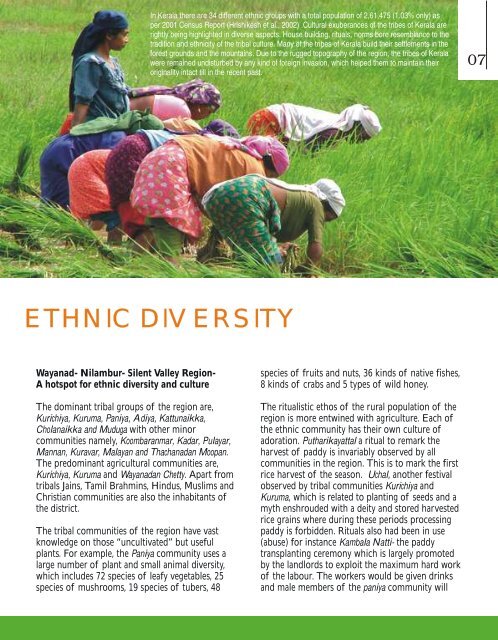Images - IUCN
Images - IUCN
Images - IUCN
You also want an ePaper? Increase the reach of your titles
YUMPU automatically turns print PDFs into web optimized ePapers that Google loves.
ETHNIC DIVERSITY<br />
Wayanad- Nilambur- Silent Valley Region-<br />
A hotspot for ethnic diversity and culture<br />
The dominant tribal groups of the region are,<br />
Kurichiya, Kuruma, Paniya, Adiya, Kattunaikka,<br />
Cholanaikka and Muduga with other minor<br />
communities namely, Koombaranmar, Kadar, Pulayar,<br />
Mannan, Kuravar, Malayan and Thachanadan Moopan.<br />
The predominant agricultural communities are,<br />
Kurichiya, Kuruma and Wayanadan Chetty. Apart from<br />
tribals Jains, Tamil Brahmins, Hindus, Muslims and<br />
Christian communities are also the inhabitants of<br />
the district.<br />
The tribal communities of the region have vast<br />
knowledge on those “uncultivated” but useful<br />
plants. For example, the Paniya community uses a<br />
large number of plant and small animal diversity,<br />
which includes 72 species of leafy vegetables, 25<br />
species of mushrooms, 19 species of tubers, 48<br />
In Kerala there are 34 different ethnic groups with a total population of 2,61,475 (1.03% only) as<br />
per 2001 Census Report (Hrishikesh et al., 2002) .Cultural exuberances of the tribes of Kerala are<br />
rightly being highlighted in diverse aspects. House building, rituals, norms bore resemblance to the<br />
tradition and ethnicity of the tribal culture. Many of the tribes of Kerala build their settlements in the<br />
forest grounds and the mountains. Due to the rugged topography of the region, the tribes of Kerala<br />
were remained undisturbed by any kind of foreign invasion, which helped them to maintain their<br />
originality intact till in the recent past.<br />
species of fruits and nuts, 36 kinds of native fishes,<br />
8 kinds of crabs and 5 types of wild honey.<br />
The ritualistic ethos of the rural population of the<br />
region is more entwined with agriculture. Each of<br />
the ethnic community has their own culture of<br />
adoration. Putharikayattal a ritual to remark the<br />
harvest of paddy is invariably observed by all<br />
communities in the region. This is to mark the first<br />
rice harvest of the season. Uchal, another festival<br />
observed by tribal communities Kurichiya and<br />
Kuruma, which is related to planting of seeds and a<br />
myth enshrouded with a deity and stored harvested<br />
rice grains where during these periods processing<br />
paddy is forbidden. Rituals also had been in use<br />
(abuse) for instance Kambala Natti- the paddy<br />
transplanting ceremony which is largely promoted<br />
by the landlords to exploit the maximum hard work<br />
of the labour. The workers would be given drinks<br />
and male members of the paniya community will<br />
07

















